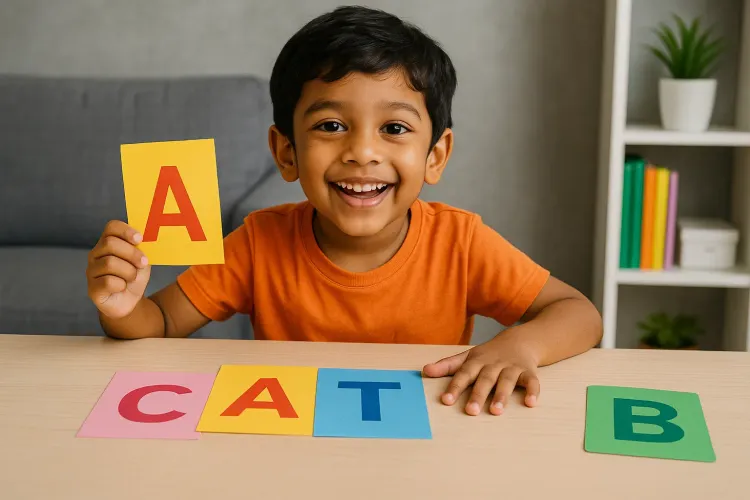Phonics for Kids in 2025: Best Methods, Books & Classes

Phonics for Kids: The Ultimate Guide for Parents in 2025
Why Phonics Matters?
Phonics helps kids decode words by connecting letters with their sounds. It builds the foundation for reading fluency and comprehension. At PlanetSpark, we make phonics simple and fun, helping your child become a confident reader.
What is Phonics for Kids?
Phonics is a teaching method that helps children understand the relationship between letters and sounds. It enables them to decode unfamiliar words by sounding them out.
There are different phonics methods including synthetic phonics, which teaches children to blend sounds to form words, and analytic phonics, which starts with whole words and breaks them down into sounds.
At its core, phonics is about helping kids hear, identify, and use different sounds to read and write. Phonics for kids simplifies complex language rules into manageable sound patterns.
Why Phonics Works: The Science Behind the Sounds
Research shows that children who are taught phonics early tend to have stronger reading skills. This is because phonics promotes phonemic awareness, a child’s ability to hear and manipulate individual sounds.
Key concepts include:
- Short vowel sounds: Like the /a/ in cat or /e/ in bed
- Blend sounds: Combining two or more consonants like /bl/ or /st/
- Vowel sounds: Recognizing both short and long vowel forms
- Phonics letter sounds: Associating each letter with its sound, like /b/ for B
Understanding these sounds allows kids to decode words, improve fluency, and build vocabulary.
Methods of Teaching Phonics to Kids
There are several proven methods to teach phonics, each with unique benefits. The key is to find a method or combination of methods that suits your child's learning style.
- Synthetic Phonics: This is the most widely used method in schools. Children learn the individual sounds (phonemes) of letters and letter groups (like /sh/ or /ai/) and then blend them together to form whole words. For example, the word "ship" is taught as /sh/ /i/ /p/.
- Analytic Phonics: This approach begins with whole words that children are already familiar with, such as "cat" or "dog." Kids then analyze these words to identify common sounds and patterns. For example, they might notice that "cat," "bat," and "hat" all end in the "-at" sound.
- Embedded Phonics: This method integrates phonics instruction into authentic reading experiences. Rather than isolated drills, children encounter new words and phonics patterns while reading stories or texts. Teachers or parents pause to explain or practice sounds as needed.
- Analogy Phonics: Children learn to read unfamiliar words by comparing them to known words. For instance, if a child knows "beak," they can decode "peak" or "leak" by analogy. This method is especially helpful for children who already have a basic phonics foundation.
- Multisensory Phonics: This method engages multiple senses—sight, sound, touch, and movement. For example, kids might use sand trays to trace letters while saying the sound aloud, or perform actions for each phoneme as in the Jolly Phonics approach. This is particularly effective for young learners and children with different learning preferences.
Each of these methods can be highly effective, especially when paired with interactive tools like songs, games, and storytelling. At PlanetSpark, we often blend these approaches to personalize learning for every child.
How to Teach Phonics to Kids at Home
Teaching phonics at home can be simple and enjoyable with the right strategies.
Here are a few methods that work:
- Use phonics worksheets to reinforce letter recognition and sound identification.
- Play phonics games that involve matching sounds and letters.
- Use letter sound flashcards to build quick recall.
- Incorporate jolly phonics songs and motions to make learning multisensory.
- Use short phonics readers that match your child’s reading level.
You can also use everyday objects to teach phonics. For example, pick an item like "bat" and help your child sound it out: /b/ /a/ /t/.
Phonics Books and Worksheets to Get Started
Books and worksheets are excellent tools to reinforce phonics skills. Here are a few you can use:
- Jolly Phonics Workbooks: Fun and interactive with illustrations.
- Bob Books Phonics Series: Perfect for beginner readers.
- Free phonics worksheets from PlanetSpark tailored by age and skill level.
Look for books that focus on short vowel sounds, blend sounds, and sight words. These help kids build decoding skills and reading fluency.
Best Apps for Kids to Learn Phonics
If you're wondering what are the best apps for kids to learn phonics, here are a few that stand out:
- Starfall Learn to Read: A classic app that uses animation and songs.
- ABCmouse: Offers a complete early learning program including phonics.
Choose apps that combine audio, visual, and interactive elements for maximum engagement.
Why Choose PlanetSpark’s Phonics Classes for Kids
At PlanetSpark, we specialize in making phonics simple and effective. Our phonics classes for kids are designed to:
- Build letter-sound association from the ground up
- Improve reading fluency and comprehension
- Enhance phonemic awareness through structured games and lessons
- Deliver live, interactive sessions with expert phonics instructors
Whether your child is just starting out or needs help catching up, PlanetSpark offers a customized learning path to build phonics skills that last.
FAQs on Phonics for Kids
How to learn phonics for kids?
Start with the basics: letter sounds, short vowels, and simple CVC (consonant-vowel-consonant) words. Use worksheets, apps, and books consistently.
What is phonics classes for kids?
These are structured lessons either online or offline, focused on teaching phonics concepts like decoding words, blending sounds, and recognizing phonics patterns.
What’s the best age to start phonics?
Most children can begin phonics between ages 3 to 5, depending on their language exposure.
Can phonics help struggling readers?
Yes. Phonics improves reading fluency and comprehension, especially for kids who find reading challenging.
How long does it take to learn phonics?
Most kids grasp the basics in 6 to 12 months with consistent practice.
Get Started with Phonics Today
Phonics gives children the building blocks for lifelong reading and learning. With the right tools, methods, and support, your child can learn to read with confidence.
Ready to unlock your child’s reading potential?
Personalized Communication Report
Record a video to get a AI generated personalized communication report for your child

Hi There, want to try these
tips for your child with
LIVE with our expert coach?
Let's check your child's
English fluency

